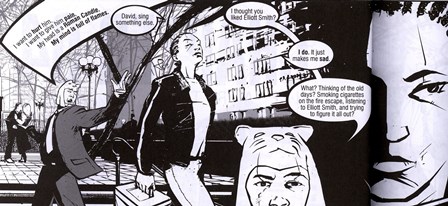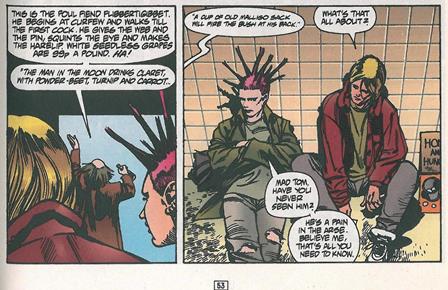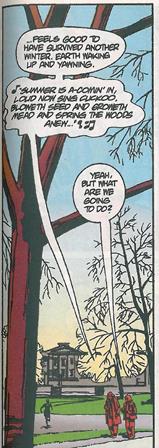This post is the first in a series on how comics artists represent talk in comics. I’ll be writing about speech balloons and how the discipline of conversation analysis (CA) helps us understand how creative these artists can be when they try to show the intricacies of everyday talk.
Consider the following two panels. These are from the webcomic Scenes from a Multiverse by Jon Rosenberg. (Click on each of the titles to see the full comic.)
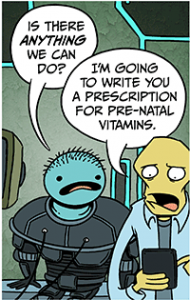
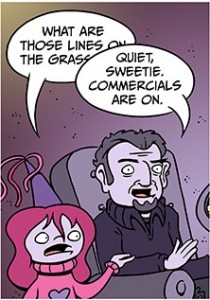
Both of these are the final panel in the comic. Specifically, each one is panel 5 of a 5 panel comic. Understanding the speech and the speech balloons in these two panels will depend on the sequencing of balloons in previous panels and, to some extent, the social context of the conversation.
In most kinds of comics, speech balloons show conversations in relatively uncontroversial ways. In smaller panels, there may be one, two, or three characters producing speech, while larger panels and full-page panels may contain a dozen or more characters talking at the same time. In conversation analysis (CA), the approach to studying talk is to keep track of the number of turns, how long the turns are, how many speakers there are, and how much silence there is, among others. This post is the first in a series about speech balloons and conversation sequence. In particular, I will focus on how comics artists draw two or more characters talking at the same time.
When two or more speakers produce speech at exactly the same time, then this is called simultaneous talk. (Sometimes it is called interruption, and sometimes it is overlap, but this depends on interpretation.) When listening to conversations, it is relatively easy to identify moments when participants are talking ‘on top of each other.’ And in transcribing the speech, there is a small set of typographical symbols that scholars typically use to do this. Consider the following excerpt, taken from an article by Emanuel Schegloff (2000) on simultaneous talk (p. 26). The two speakers, Anne and Dick, are an elderly couple who have been married for a long time. In this short excerpt, we see a good bit of simultaneous talk. Anne and Dick are having a conversation with their daughter, and it takes a funny turn in that Dick gives Anne a hard time about spending money on shoes and her claim about how many pairs of shoes she owned.

SOURCE: Schegloff, E. (2000). Overlapping talk and the organization of turn-taking for conversation. Language in Society, 29 (1): 1–63.
Lines 52 and 53 are clear examples. According to this transcription, at exactly the same time that Dick begins the word ‘six,’ Anne begins her utterance with ‘WHY’. The effect is that while Dick already has the conversational floor, Anne joins in, and the listeners have to keep track of what both of them are saying. At the end of Dick’s word ‘shoes’, he stops speaking but Anne continues her turn through line 54. The use of all capital letters indicates that Anne is using a LOUD volume.
It’s one thing to listen to speech and write it down in a transcription. But in comics, it seems to me that it’s a creative challenge to represent simultaneous speech using speech balloons. In other words, how does an artist use visual cues (putting one balloon on top of another) to signal a certain kind of verbal cue (two or more speakers talking at the same time)?
The question I have is whether the visual difference in the balloons has a material impact on the way readers ‘hear’ the speech. Does the doctor’s turn ‘sound the same’ as the dad’s turn? If there is a difference, is it a difference of kind or a difference of degree? To answer the questions, we should examine each of the comics in terms of conversation and speech balloons.
The Symbiote
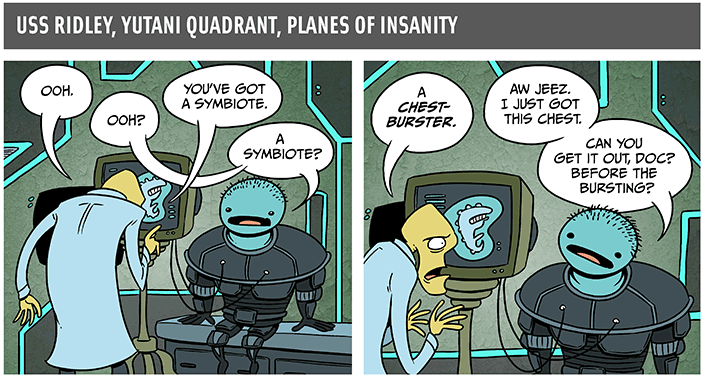
The first two panels of ‘The Symbiote’ show very traditional strategies for representing turns and turn-taking. The doctor in panel 1 begins the sequence, with the patient taking the second turn, and the two trading off in panel 2 as well. Even though the tails cross in panel 1, I think readers would perceive these turns as more or less separate, perhaps with no simultaneous speech at all. In panel 2, the visual separation of the balloons is even clearer, indicating that the two speakers are being careful to take turns without ‘stepping on each other’s toes.’
The Superbowl (sic)
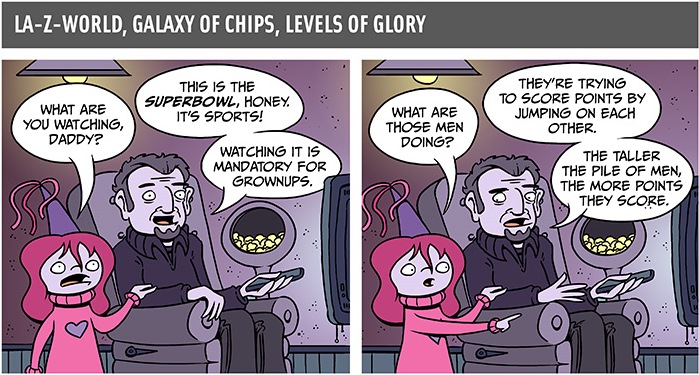
In panels 1 and 2 of ‘The Superbowl,’ the speech turns proceed much like those in ‘The Symbiote.’ I think the visual separation of speech turns here is crisp, with the tails of the balloons never crossing. The content of the balloons indicates that the daughter takes the first turn by asking a question and the dad takes the second turn by answering the question. This is true for both panels.
If we consider the sequence of panels 3-4-5 in both comics, we may be able to discern more readily whether the speech in the final panels are indeed different kinds of simultaneous speech.
| The Symbiote |
| Panel 3 |
Panel 4 |
Panel 5 |
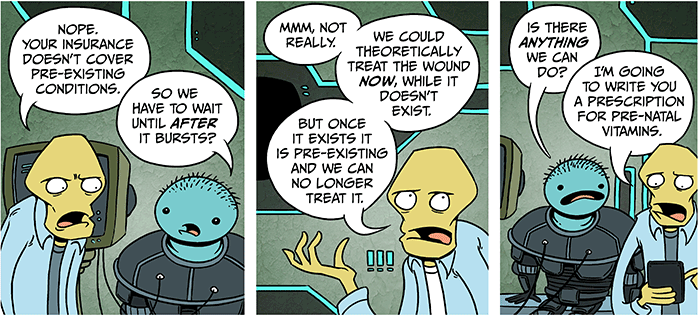
| The Superbowl |
| Panel 3 |
Panel 4 |
Panel 5 |
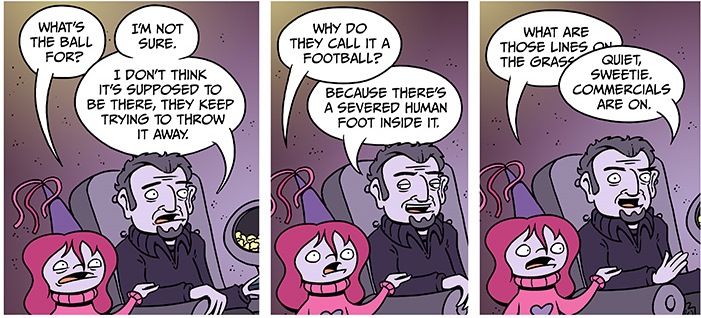
In both comics, panel three is composed very similarly. The speech balloons of speakers 1 and 2 are touching, and in fact the balloon of speaker 2 is ever so slightly overlaid onto the balloon of speaker 1. Panel 4 in ‘The Symbiote’ has just one speaker, the doctor, but Panel 4 in ‘The Superbowl’ shows the two speakers producing some measure of simultaneous talk.
As we saw at the beginning of this post, panel 5 for both comics shows that one balloon is overlaid on top of the other. It is more than likely that readers are supposed to ‘hear’ simultaneous talk. In other words, the doctor talks at the same time as the patient, and the dad talks at the same time as the daughter.
What interests me about them is that in both panels, one speech balloon overlaps the other. There are some slight differences, however. In ‘The Symbiote,’ the doctor’s speech balloon overlaps the patient’s speech balloon, but all the words are visible. On the other hand, in ‘The Superbowl,’ the dad’s balloon overlaps the daughter’s but also partially obscures two words (on and grass). What is not clear is whether the balloon obscures additional words or other symbols in the balloon, symbols like ellipses (…). But is the amount of simultaneous talk the same? If we hear the panels differently, what elements of each comic are we meant to consider when we decide how they sound?
When you read these two comics, how do you ‘hear’ the turns playing out? What might Rosenberg be trying to accomplish by drawing one speech balloon on top of another? How much does the turn-taking sequence affect our perception of the balloons? And how much of an impact does the social context or the identity of the speakers have?
In part 2 of this series, I’ll talk about simultaneous discourse in Grant Morrison’s The Invisibles.

